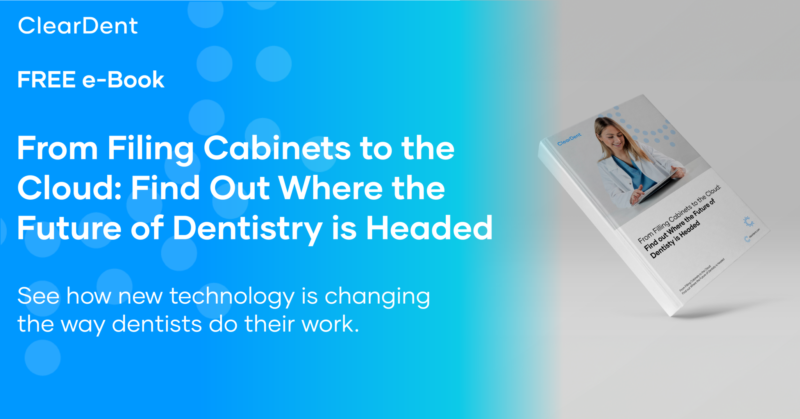The Technology Powering the Practice of the Future

Dentistry, despite being a critical aspect of healthcare, has historically lagged other industries in adopting the latest technologies. While areas like information technology, manufacturing, and even other medical specialties have been quick to embrace advancements like artificial intelligence, digital record keeping and management systems, and big data analytics, dentistry has been relatively conservative. This slower pace of technology adoption and integration can be attributed to the high cost of new technology, a lack of training and resources to learn and implement these technologies, and a general hesitation within the industry to shift away from traditional practices that have been effective for decades. But perhaps there’s more to it.
Dentistry is, after all, an evidence-based profession. This approach allows dentists to see through hype and seek evidence to verify that technology can work, and then validate the outcomes after adoption to confirm the solutions are effective. That’s been the case with other notable advances in dentistry like the adoption of CBCT, Digital Impressions, and more. So, if dental professionals are more pragmatic than the public and just as eager for innovation, then why has technology adoption lagged?
Perhaps the problem is that despite an abundance of information, there is an overall lack of clarity in the industry around how modern technologies will either solve real business problems or create new efficiencies or opportunities for growth.
On the Verge of a Big Shift
Dentistry is standing on the cusp of a technological revolution, poised to transform the way dental care is delivered and experienced. Advancements in digital dentistry, like 3D printing and computer-aided design and manufacturing (CAD/CAM), are reshaping prosthodontics and orthodontics, allowing for more precise and customized treatments. Artificial intelligence (AI) has the potential to revolutionize diagnostic processes, enabling earlier detection of dental issues and more effective treatment planning, while tele dentistry is expanding access to dental care, especially in remote areas, by enabling virtual consultations and diagnostics.
Understanding the “Cloud”: The backbone of emerging technologies
Cloud technology is essentially the delivery of various services through the Internet. For dental practices, cloud technology offers several benefits, from streamlined data management, including patient records and appointment schedules, to facilitating patient engagement. This enables dental practice to be more efficient, collaborative, and patient-focused, while ensuring data security and compliance with healthcare standards. These shifts are enabling dental professionals to provide higher quality care with more flexibility and efficiency.
The technology also supports patient engagement through user-friendly portals, where patients can access their dental records, schedule appointments, and communicate with their dentists. Finally, cloud technology simplifies administrative tasks for dental practices by automating software updates and maintenance, reducing operational costs, and allowing scalability to meet the changing needs of the practice.
Another driver of cloud-based technology adoption is the trend towards larger and multi-site practices and Dental Service Organizations (DSOs). As practices merge or expand, cloud technology enables centralized data storage and easy access to patient records, ensuring consistency in treatment and patient history regardless of the clinic location. It enables job sharing, a remote workforce, call centers and billing departments that can support the entire organization.
With that said, cloud solutions also level the playing field for the solo practice owner. Cloud solutions can be equalizers in many ways, keeping the solo practice relevant and able to deliver patient care and experiences comparable to their DSO peers while increasing the overall value of the practice to a would-be buyer.
The Technologies Steering the Future Practice
Platforms and point solutions:
Software platforms and point solutions represent two fundamentally different approaches in software applications. Software platforms provide a comprehensive and integrative framework for developing a wide range of applications, offering scalability and customization to suit evolving business needs. They are specifically designed for broad functionality and are typically compatible with various systems. In contrast, point solutions are specialized software products focused on addressing a single, specific business need. They excel in their targeted area but have limited scope and functionality compared to platforms. While they can sometimes integrate with other systems, they are not inherently designed for extensive compatibility.
Cloud versus on-premises software:
The primary difference between cloud and on-premises solutions in dentistry lies in their data storage and accessibility methods. Cloud solutions store data in data centers, accessible over the internet, offering dentists flexibility and mobility in accessing patient records and practice management tools from any location. On-premises solutions involve data stored on local servers or computers within the dental practice. This approach offers direct control over data and can be more customizable to specific practice needs, but it often requires significant upfront investment in hardware and IT infrastructure. On-premises solutions typically demand more hands-on maintenance and updates, and they may pose challenges in data accessibility and mobility compared to cloud solutions. In essence, while on-premises solutions offer control and customization, cloud solutions provide flexibility, scalability, and ease of access.
But buyers beware of the “cloud-washed” solutions. True cloud solutions and cloud-washed solutions differ significantly in their architecture, functionality, and benefits. True cloud solutions are designed natively for cloud environments, offering robust scalability, flexibility, and data accessibility from anywhere, typically via a web browser. They utilize multi-tenant architectures, allowing multiple users to access a shared infrastructure with cost-efficiency and security. On the other hand, cloud–washed solutions are essentially older on-premise software that is being hosted on a virtual machine so that it is accessible over the internet (aka. legacy software rehosting). Not only was it not designed to be used over the internet, but it lacks the full range of functionality and benefits of a true cloud environment. As more and more users try to simultaneously access hosted software (versus true cloud solutions), it’s likely to lead to slow response times, timeouts, or page load issues. Simply put, “cloud-washed” software doesn’t offer the same level of scalability, data security, or cost-effectiveness that true cloud solutions do and are limited in their ability to continuously innovate and conduct real-time data backups. The distinction is crucial for businesses, as choosing a cloud-washed solution can lead to limited growth potential, higher costs, and compromised data security.
Artificial Intelligence:
Artificial Intelligence (AI) stands to revolutionize dentistry, both in its current applications and future potential. Today, AI is enhancing diagnostic accuracy, enabling dentists to detect cavities, gum disease, and even oral cancer more effectively and at earlier stages. It aids in analyzing radiographs and other imaging with greater precision, reducing the chances of human error. Looking ahead, AI’s potential in predictive analytics promises a significant impact on preventive dentistry. It could streamline administrative tasks in dental practices, from appointment scheduling to patient follow-up, enhancing overall practice efficiency. In dental research, AI’s capability in processing vast amounts of data rapidly accelerates research and discovery, potentially leading to groundbreaking treatments and technologies. Ultimately, AI in dentistry represents a frontier of innovation, promising enhanced patient care, improved operational efficiency, and a new horizon in dental science and technology.
Business Intelligence:
Business Intelligence (BI) is significantly impacting dentistry in a positive way, driving improvements in operational efficiency, patient care, and strategic decision-making. By leveraging data analytics, practices are gaining insightful metrics and trends related to patient demographics, treatment outcomes, and practice performance. This data-driven approach enables practitioners to identify areas for improvement, optimize appointment scheduling, and manage patient flow more effectively, leading to increased productivity and reduced wait times. BI tools also assist in financial management, providing detailed revenue analysis and identifying profitable services or areas where costs can be reduced. Overall, Business Intelligence transforms raw data into actionable insights, empowering dental practices to operate more efficiently, make more informed decisions, and ultimately provide superior patient care.
Digital Dentistry:
Digital dentistry will continue to revolutionize the field, enhancing precision, efficiency, and patient experiences. It encompasses a range of technologies including digital imaging, CAD/CAM, and CBCT which streamline the diagnostic and treatment processes. For instance, CAD/CAM technology enables the in-office fabrication of dental restorations like crowns and bridges, reducing the time and visits required for these procedures. Digital impressions are more comfortable for patients compared to traditional methods, improving their overall experience, and leading to better outcomes. Digital workflows allow for better communication and collaboration among dental professionals, with patients, making consultations more informative and engaging. 3D printing, a rapidly emerging aspect of digital dentistry, is opening new possibilities for custom prosthodontics and orthodontics, further customizing patient care. Overall, digital dentistry is transforming traditional practices and will continue to do so, offering a higher standard of care, enhanced accuracy, and greater comfort for patients.
Other important technologies shaping the practice of the future:
Advances in other areas like Patient Education, Patient Communication, Human Resources (HR), Inventory Management, and Cybersecurity are poised to significantly shape the future of dentistry. Enhanced patient education tools, leveraging interactive and digital platforms, will empower patients with a better understanding of their dental health, leading to more informed decisions and increased compliance with treatment plans. In HR, sophisticated software solutions for workforce management will optimize staffing, training, and employee satisfaction. Inventory management systems will become more advanced, utilizing AI and data analytics for efficient stock monitoring and ordering, reducing waste and ensuring the availability of necessary supplies. Lastly, as dental practices increasingly rely on digital technologies, robust cybersecurity measures will become paramount to protect sensitive patient data and maintain trust. These advancements, collectively, will not only enhance the quality of dental care but also improve the operational efficiency and security of dental practices, heralding a more connected, efficient, and patient-centric future in dentistry.
One Dentists’ Journey to Future Proofing His Practices
At 52, Edmonton-based dentist Dr. Terry Orsten hung up the white coat and began the journey to retirement. Not long after, he was summoned back to practice when a friend and colleague abruptly lost his partner prior to going on a month’s long vacation – potentially leaving the practice unattended.
That brief stint was the rebirth of Dr. Orsten’s dental career, where he established a new partnership that would ultimately lead him to where he is today, personally operating 9 practices in Alberta, within a larger group of 50+ practices.
Having dabbled outside of dentistry and being father to a programming son who works at Apple, Orsten was no stranger to technology and in fact, quite passionate about the efficiencies it could bring. He was the second dentist in Alberta to embrace digital x-rays when they came to market, and never looked back. In his practice journey 2.0, he is “all-in” on tech and is using it in innovative ways to build a well optimized, thriving group of practices. Orsten’s current success can be attributed to several things including digital marketing, modern technology adoption, centralized functions, coaching and mentoring, and data, data, and more data.
Orsten is something of a pioneer when it comes to using digital marketing strategies and has refined the processes and platforms to attract new patients in a predictable, repeatable way. Once refined, his next challenge was to create the capacity to efficiently intake all those new patients and seamlessly schedule them across their different practices without disrupting the in-office workflows and client care. To solve this, Orsten and the team built a call centre. It took some time to get the kinks out and settle on the technology that enabled the call centre’s ultimate success; call handling tools and cloud-based practice management software, but as Orsten says, “It’s one of the best decisions I’ve ever made.”
An early adopter of ClearDent’s first cloud iteration, he was able to realize the efficiencies of a call centre, and over time, add new offices to the platform as they were built or acquired. He and his team tested other cloud solutions, but “none could compete with ClearDent’s functionality, ease-of-use, and reporting”. Once the full ClearDent Cloud product came to market in 2022-23, Orsten and team were able to transition to a true cloud environment that could easily scale to meet their growth.
One thing Orsten says is at the heart of running a successful practice is data and insights. He uses data to make decisions across the business and gave up “guessing” a long time ago. In fact, Orsten’s advice to today’s dentists is to “know your numbers so that you can solve problems faster and more accurately, and better understand your ability to invest in growth initiatives.” And cloud solutions are the key source of the information he uses to analyze performance. He meticulously looks at the data produced from ClearDent Cloud to understand what’s working and what isn’t.
But we would be remiss if we didn’t acknowledge another key to Orsten’s success; the commitment to training and mentoring. From call centre to front desk to operatory, the business is dedicated to coaching and learning at all levels.
So, what’s next for Orsten and the team? You guessed it, artificial intelligence. Dr. Orsten is looking for ways to use AI to further optimize various aspects of his group practice and will be working alongside his current technology partners to bring that to fruition.
When asked for his advice for other practice owners wondering which direction to go next with technology, Orsten’s response is, “Be really clear about how much extra dentistry you’ll have to do to pay for technology (even if it flops) and convert that into weekly and even daily revenue/service targets. Determine if that’s a number you can live with and if it is, go for it! Then carefully monitor your numbers to see if the technology did deliver the results or not. If not, reexamine your implementation and training, to see if you can make better and more efficient use of it. You should always stretch yourself, within reason, to have tools and technology that will drive growth and efficiencies.”
Are you ready to be a Cloud-Powered Practice?

Peter P. Li, Co-founder | ClearDent
Peter Li has spent the better part of his career understanding and innovating in dentistry and entrepreneurship. As one of the founders of ClearDent in 2002, Peter took the time to understand the risks and demands facing oral healthcare professionals and helped to build a practice management software platform and a suite of tools designed to streamline the business process and bring the focus of dental care back to the patient.
Peter frequently collaborates with other industry leaders to build a better community for entrepreneurs and healthcare providers. A proud husband and avid dog adopter, Peter now travels the country providing insight and understanding to dentists, practice owners, and office managers.







